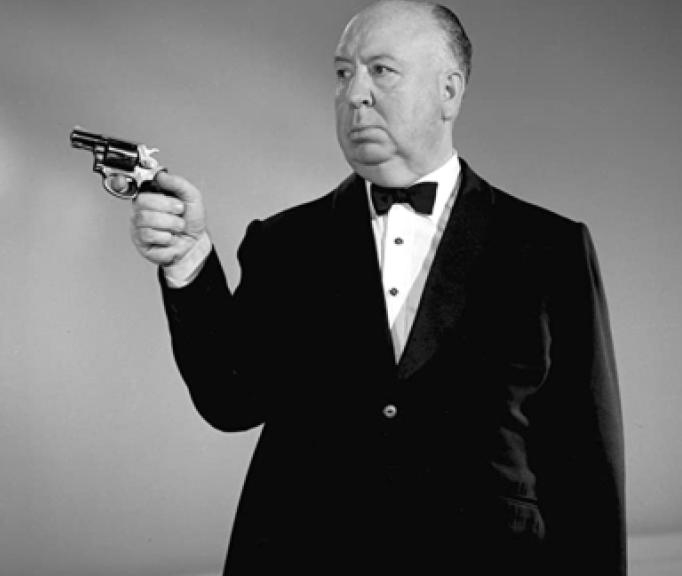Hitchcock: the man behind the camera
Hitchcock drew upon his troubled childhood to create his masterpiece films
Sir Alfred Hitchcock — the “Master of Suspense” — is a legendary filmmaker known for 53 acclaimed psychological films spanning five decades from 1920 to 1976. While he never received an Academy Award for his work, he may be the most famous and admired film director in motion-picture history. Growing up in London in the early 20th century, Hitchcock often felt sheltered and lonely due to his obesity. As a child, Hitchcock experienced odd and severe punishment from his parents — his mother would demand he stand at the end of her bed for hours, and his father would send him to the local prison to be locked up for 10 minutes for bad behavior. His films later became an outlet for expressing the impact of his troubled upbringing. Hitchcock was a serious and dedicated filmmaker, yet he loved to pull pranks on set. These pranks ranged from the innocent placement of Whoopee Cushions under people’s chairs to handcuffing two leads together and pretending to lose the key, to even sending actors boxes of mice or spiders to trigger their phobias. His dark humor and his joy in tormenting other people for fun also inspired his work as a director. Hitchcock was famed for mapping out every detail of a film before shooting it, using his great visual gifts to steer and manipulate the emotions of the viewer down to the finest detail. The victimized boy became the victimizing director. In his film, “The Lady Vanished” (1938), Hitchcock made his first of many cameo appearances. Once his series of cameos began, film lovers would continually search for Hitchcock in each film. He is often seen getting on a train or bus, walking through a crowd or even carrying an instrument. There is also something known as the “Hitchcock Blonde”, a mysterious, sexually appealing and, of course, blonde female lead who represents Hitchcock’s ideal woman. A perfect example of this trope is Grace Kelly, who acted in “Dial M for Murder” (1954), “Rear Window” (1954), and “To Catch a Thief” (1955). Hitchcock enjoyed exerting his control over Kelly as he wore her down on set. In another instance, with Tippi Hedren, Hitchcock tormented her and caused her to have PTSD. When filming a scene in “The Birds” (1963), Hitchock used string to tie real birds to Hedren’s body in a confined space. She was then attacked by the birds, leaving not only her character scarred, but also her own mental wellbeing. On a personal level, Hitchcock was an emotionally flawed human being. As a filmmaker, he exploited his internal conflicts in the service of creating films that have revolutionized the psychological thriller genre. To understand Hitchcock’s films, we cannot easily separate the art from the artist or ignore how his emotions play a key role in the development of his many masterpieces.
March 31, 2022
Sir Alfred Hitchcock — the “Master of Suspense” — is a legendary filmmaker known for 53 acclaimed psychological films spanning five decades from 1920 to 1976.
While he never received an Academy Award for his work, he may be the most famous and admired film director in motion-picture history. Growing up in London in the early 20th century, Hitchcock often felt sheltered and lonely due to his obesity.
As a child, Hitchcock experienced odd and severe punishment from his parents — his mother would demand he stand at the end of her bed for hours, and his father would send him to the local prison to be locked up for 10 minutes for bad behavior. His films later became an outlet for expressing the impact of his troubled upbringing.
Hitchcock was a serious and dedicated filmmaker, yet he loved to pull pranks on set. These pranks ranged from the innocent placement of Whoopee Cushions under people’s chairs to handcuffing two leads together and pretending to lose the key, to even sending actors boxes of mice or spiders to trigger their phobias.
His dark humor and his joy in tormenting other people for fun also inspired his work as a director. Hitchcock was famed for mapping out every detail of a film before shooting it, using his great visual gifts to steer and manipulate the emotions of the viewer down to the finest detail. The victimized boy became the victimizing director.
In his film, “The Lady Vanished” (1938), Hitchcock made his first of many cameo appearances. Once his series of cameos began, film lovers would continually search for Hitchcock in each film. He is often seen getting on a train or bus, walking through a crowd or even carrying an instrument.
There is also something known as the “Hitchcock Blonde”, a mysterious, sexually appealing and, of course, blonde female lead who represents Hitchcock’s ideal woman. A perfect example of this trope is Grace Kelly, who acted in “Dial M for Murder” (1954), “Rear Window” (1954), and “To Catch a Thief” (1955).
Hitchcock enjoyed exerting his control over Kelly as he wore her down on set. In another instance, with Tippi Hedren, Hitchcock tormented her and caused her to have PTSD. When filming a scene in “The Birds” (1963), Hitchock used string to tie real birds to Hedren’s body in a confined space. She was then attacked by the birds, leaving not only her character scarred, but also her own mental wellbeing.
On a personal level, Hitchcock was an emotionally flawed human being. As a filmmaker, he exploited his internal conflicts in the service of creating films that have revolutionized the psychological thriller genre.
To understand Hitchcock’s films, we cannot easily separate the art from the artist or ignore how his emotions play a key role in the development of his many masterpieces.












